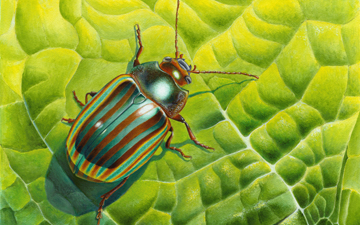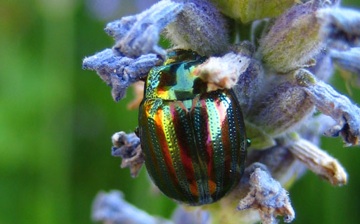Chrysolina americana is a type of beetle native to Southern Europe, despite the species name americana. Commonly known as the ‘Rosemary Beetle’ it feeds on rosemary and lavender.
This species was first discovered living outdoors in the United Kingdom in 1994. By 2002 it had become widespread in the London area, and spreading rapidly throughout. Although it is susceptible to some pesticides, it is usually recommended that home growers pick off beetles by hand, or shake them off onto a sheet of paper to remove them, if the plant affected by them is intended for culinary purposes.
(From Wikipedia, 6 October 2011)
Rosemary leaf beetles have a metallic green body with red and blue stripes running the length of the body. In the sunlight these stripes reflect all the colours of the rainbow – rather like oil on water.
Despite the scientific name, this beetle is a native of southern Europe. It was first noticed in the U.K. in the early 1990s and has since become well established.
The larvae are a creamy-white colour, with grey lines along their length.
(From UK Safari, 6 October 2011)
The rosemary beetle (Chrysolina americana) devours the leaves of rosemary, lavender, thyme, sage and some other related plants.
It is an attractive 8mm long metallic green beetle with purple stripes on its wing cases and thorax.
The beetle is a native of southern Europe that has become an established pest in Britain since the 1990s.
The soft-bodied grubs are greyish white with five dark longitudinal lines; fully grown larvae are 5-8mm long. Sausage-shaped eggs, 2mm long, may be found on the underside of the leaves from early autumn to spring.
Research in the entomology laboratory at Wisley Garden indicated that rosemary beetle adults remain relatively inactive on their host plants during July and August. In late August and September the beetles resume feeding, mate and lay eggs, which they continue to do on warm winter days until spring. The eggs hatch within two weeks and the larvae feed for as little as three weeks before entering the soil to pupate. The pupal stage lasts for a further two to three weeks before adults emerge.
(From RHS, 6 October 2011)





